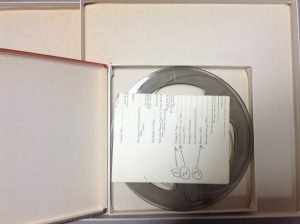
To Do (ASAP)
- Meet with Scott Schwartz. I’ve emailed him twice and stopped by the Sousa during his office hours but haven’t had any luck. He’s busy but I will track him down this week.
- Digitize video content. Josh Harris has been out of town but he is supposed to be returning today. I will follow up on contacting him.
- Record the University of Oregon tape, ascribe the appropriate metadata (PBCore). Contact other schools that have tapes in the archive (SIU, MSU, etc.)
To finish up with:
- Finish cataloging all materials. Measure materials in footage for the finding aid.
- Take detailed pics of the room showing natural order of materials.
- Get materials ready for transition.
One of the goals over the next few weeks is to provide access to the materials for any parties that have a historical or cultural connection to those materials. This is important because once these materials enter the Sousa Archives, the processing and copyright verification will take a very long time and some materials will never get digitized. I fear that there is a narrow window to making sure that some of the institutions outside of the University of Illinois know about and have access to the historic materials created by their faculty (or in their studios).
For example, I contacted the University of Oregon about a tape that I found in the archive the reply I received demonstrated the importance of some of these tapes to other institutions.
In reply to my inquiry to the University of Oregon regarding a tape I found, a faculty member responded:
It seems to be student and faculty compositions from Don L. Hunter’s electronic music course. Mr. Hunter passed away last year at the age of 101! He started making sound recordings in the 1930s and I have been working to acquire and process his collection for the past few years.
He started the Audiovisual Department at UO in 1946 and made sound recordings documenting musical culture at University of Oregon, arts and culture in Lane County, railroads and industry in the Pacific Northwest, and the cultural and natural history of Oregon.
There is a wonderful photograph of him recording steam locomotives in stereo in the 1950s when that technology first became available. He also left us with a truly endearing, self published autobiography in which he mentioned his electronic music compositions.
I hadn’t known about these and made a special trip back to his house after his death and before the estate sale to retrieve any recordings. I found some of them but not this one so we would very much like a digital copy if you are able to provide one.
Helping institutions, musicians, and researchers understand the legacy and history of the content that was created within their own institutions is an essential part of why I’m doing this project.

